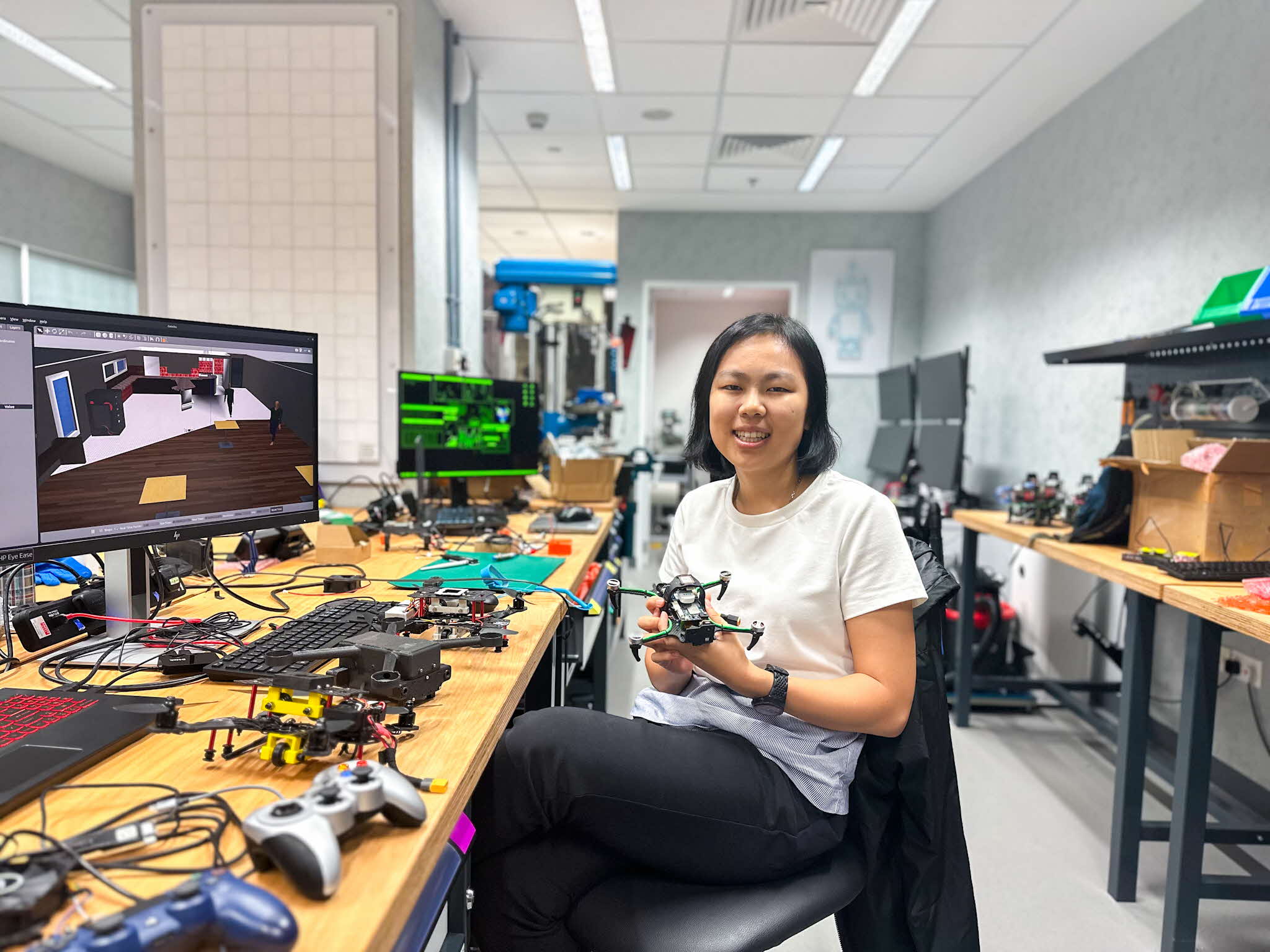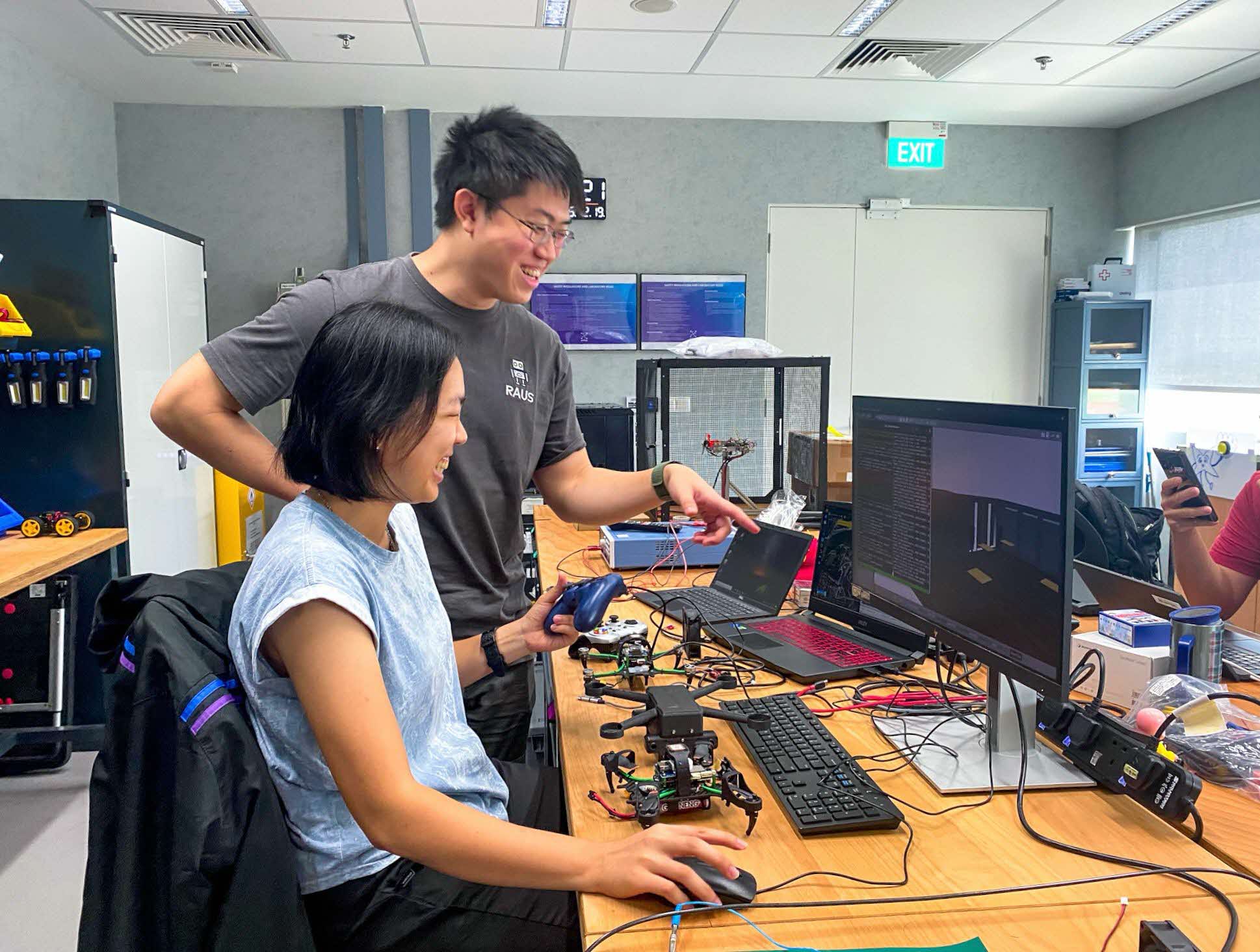
(Photo: HTX)
On a fateful day in London, 387,036 civilians were killed by a swarm of robot bees, dubbed Autonomous Drone Insects (ADIs), which were hijacked by a mysterious hacker. Thankfully, this tragedy is just a fictional episode from the sci-fi series, Black Mirror. But is drone swarm technology all a dystopian nightmare for our future as depicted in the media? Our Robotics Software engineer, Ker Chin Tian, tells us how it can be used for the greater good in homeland security missions.
While drone swarms may be the new face of modern warfare and destruction, these novel capabilities are currently being explored at HTX to save lives and solve crimes. That is what Chin Tian is optimistic about and has gotten the opportunity to work on since she started her journey with HTX last July.
Chin Tian’s team from the Robotics, Automation & Unmanned Systems (RAUS) Centre of Expertise (CoE) is exploring the use of drone swarms – or multiple Unmanned Aerial Vehicles (UAVs) that operate autonomously and intelligently together – to aid homeland security missions such as finding missing persons and threat detection through environment mapping and imaging.
"It’s the teamwork here that will take us far."
With advanced computer algorithms, local sensing, and communication technologies, these drones will be used to collect vital information about unknown environments to improve response readiness of officers.
Still in the early stages of running simulations, Chin Tian is building on the features of the current Aperture unit – a palm-sized, cellular Beyond Visual Line of Sight (BVLOS) drone – to include indoor exploration and object detection. After these capabilities are in place, the drones will be trained to carry out missions in swarms through various methods of command and control.

Working closely with Chin Tian is fellow engineer Samuel Chew who is also working on drone swarm capabilities, but for outdoor exploration. (Photo: HTX)
Sinking her teeth into the research
To Chin Tian, the most interesting part of the research so far has been the study of animal and insect colonies with collective behaviours that help them adapt and survive in the wild.
“Studying how birds and bees behave and respond in groups offers insight into how drones can similarly operate in swarm systems, ideally to the capability level that was imagined in Black Mirror’s episode,” Chin Tian shared. “Eventually, we want the UAVs to make decisions on their own, communicate with one another, and avoid obstacles like animals and insects do.”
“Swarms also make for a more efficient, reliable, and formidable line of defense and security because when one drone fails, the others can still work on the task,” she elaborated, “Tasks will be also able to be completed much faster
and with more blind spots covered, as opposed to individual drones working in silos.”
In it for the long game
As drone swarm technology is still a fairly new frontier of technological advancement with limited updated sources of research documentation, Chin Tian foresees that it will take some time before achieving a significant breakthrough.
For instance, getting a single drone to fly safely and accurately in uncontrolled environments with unpredictable weather conditions is currently still in the works, and much easier said than done. She experienced this firsthand when getting her Unmanned Aircraft Pilot License which required her to learn how to pilot a drone outdoors.
“Drones are susceptible to factors like winds which makes it hard to track and determine their position,” she explained, “The current UAVs developed in the market still lack a robust localisation system unaffected by Global Navigation Satellite System (GNSS) multipath effects that tend to render position and velocity estimates inaccurate.”
Although the road of progress seems long, Chin Tian is unfazed by the idea of failing: “To me, failing is part of the process of getting somewhere. The trick is to keep trying and not be afraid to push boundaries.”
“What helps is also when you’re working on it together with others,” she added. “Similar to the cohesiveness we’re trying to achieve in drone swarms to accomplish successful operations, it’s the teamwork here that will take us far.”

The RAUS team at HTX’s 2023 Annual Dinner & Dance. (Photo: Chin Tian)

Chin Tian is also part of the Table Tennis Community of Interest (COI) group. They participated in the last Home Team Games and clinched the champion title. (Photo: HTX)
Are you a STEM talent looking for opportunities to explore new frontiers of Science and Technology that make a difference to safeguarding Singapore? Find out more about the HTX Associate Programme or check out our current job openings.
We are always seeking inquisitive and innovative individuals to co-create extraordinary solutions with us.
Join us to be at the forefront of the finest tech capabilities in the field! Join Us

